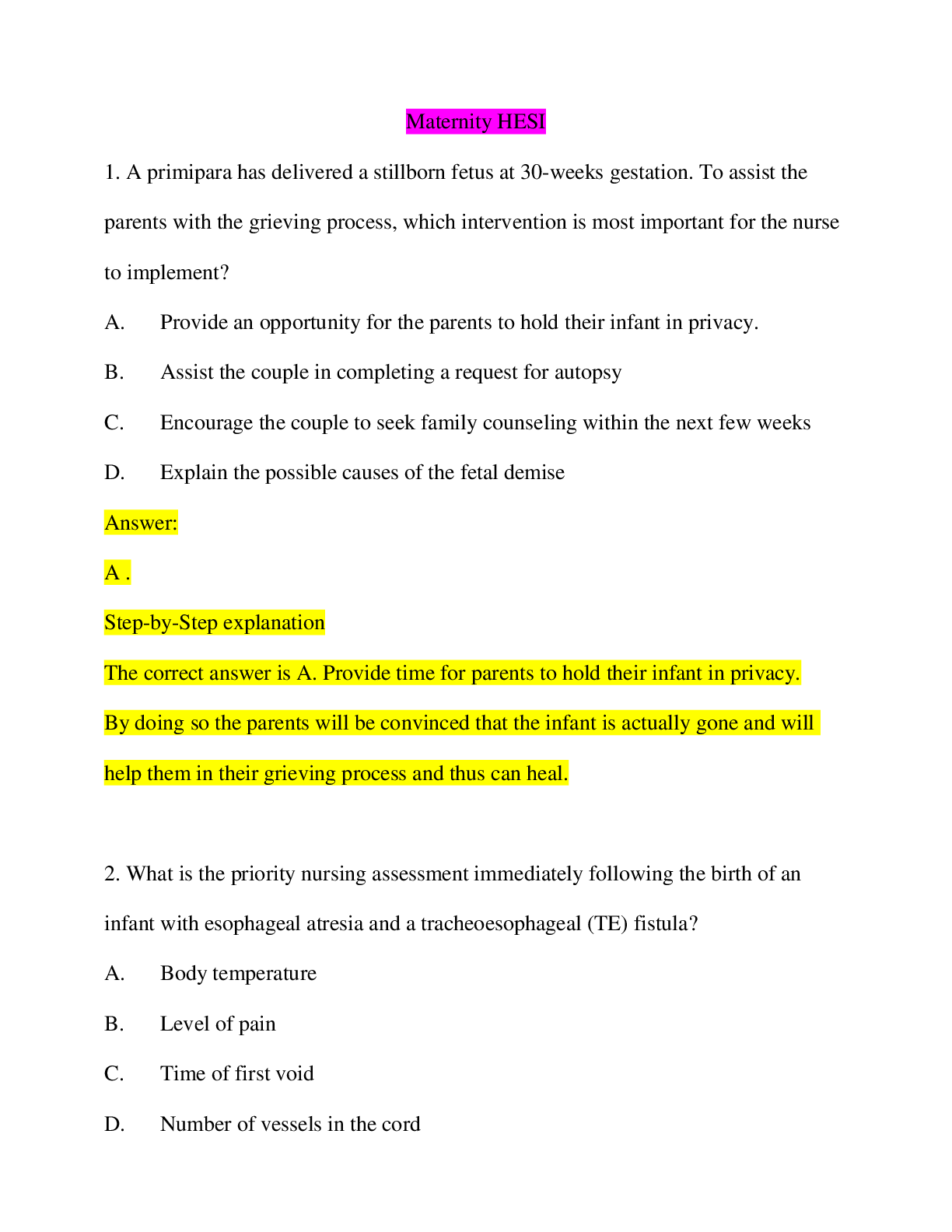HESI EXAM PRACTICE QUESTIONS AND ANSWERS SOLUTION 2021
Document Content and Description Below
HESI EXAM PRACTICE QUESTIONS AND ANSWERS SOLUTION 2021 A client with a serum sodium level of 125 meq/mL should benefit most from the administration of which intravenous solution? ⦁ 0.9% sodium chlor... ide solution (normal saline) ⦁ 0.45% sodium chloride solution (half normal saline) ⦁ 10% Dextrose in 0.45% sodium chloride ⦁ 5% dextrose in 0.2% sodium chloride ⦁ A client with Alzheimer’s disease falls in the bathroom. The nurse notifies the charge nurse and completes a fall follow-up assessment. What assessment finding warrants immediate intervention by the nurse? ⦁ Urinary incontinence ⦁ Left forearm hematoma ⦁ Disorientation to surroundings ⦁ Dislodge intravenous site ⦁ Rationale: The left forearm hematoma may be indicative an injury, such as broken bone, that requires immediate intervention. A may be likely be due to the inability to use the toilet due to the fall. Disorientation is a common symptom of Alzheimer’s disease. IV Dislodged is not an urgent concern. ⦁ The nurse is triaging clients in an urgent care clinic. The client with which symptoms should be referred to the health care provider immediately? ⦁ headache, photophobia, and nuchal rigidity ⦁ high fever, skin rash, and a productive cough ⦁ nausea, vomiting, and poor skin turgor ⦁ malaise, fever, and stiff, swollen joints ⦁ Rationale: Headache, photophobia, and nuchal rigidity are classic signs of meningeal infection, so this client should immediately be referred to the health care provider. AC D do not have priority of B ⦁ An adult male is brought to the emergency department by ambulance following a motorcycle accident. He was not wearing a helmet and presents with periorbital bruising and bloody drainage from both ears. Which assessment finding warrants immediate intervention by the nurse? ⦁ Rebound abdominal tenderness ⦁ nausea and projectile vomit ⦁ rib pain with deep inspiration ⦁ diminished bilateral breath sounds ⦁ Rationale: Projective vomiting is indicative of increasing intracranial pressure, which can lead to ischemic brain damage or death, so this finding warrants immediate intervention. Rebound abdominal tenderness may indicate internal bleeding. Diminished breath sound may be related to pain. Rib pain with inspiration may indicate rib fracture. ⦁ After placement of a left subclavian central venous catheter (CVC), the nurse receives report of the x-ray findings that indicate the CVC tip is in the client’s superior vena cava. Which action should the nurse implement? ⦁ Initiate intravenous fluid as prescribed ⦁ Notify the HCP of the need to reposition the catheter ⦁ Remove the catheter and apply direct pressure for 5 minute ⦁ Secure the catheter using aseptic technique ⦁ Rationale: Venous blood return to the heart and drains from the subclavian vein into the superior vena cava. The X-ray findings indicate proper placement of the CVC, so prescribed intravenous fluid can be started. A and B are not indicated at this time. The catheter should be secure immediate following insertion (C) ⦁ The nurse has received funding to design a health promotion project for African-American women who are at risk for developing breast cancer. Which resource is most important in designing this program? ⦁ A listing of African-American women so live in the community ⦁ Participation of community leaders in planning the program ⦁ Morbidity data for breast cancer in women of all races ⦁ Technical assistance to produce a video on breast self-examination. ⦁ Rationale: When developing a culturally-competent health promotion project, the participation of stakeholders and community leaders is most important. A and B might be useful background information, but t=first the program should be developed. D may be useful fulfilling the plan developed by the health care team and the community leaders if funding for this assistance is included in the budget. ⦁ The home care nurse provide self-care instruction for a client chronic venous insufficiency cause by deep vein thrombosis. Which instructions should the nurse include in the client’s discharge teaching plan? Select all that apply ⦁ Avoid prolonged standing or sitting ⦁ Use recliner for long period of sitting ⦁ continue wearing elastic stocking ⦁ Maintain the bed flat while sleeping ⦁ Cross legs at knee but not at ankle ⦁ The nurse is interviewing a client with schizophrenia. Which client behavior requires immediate intervention? ⦁ Lip smacking and frequent eye blinking ⦁ Shuffling gait and stooped posture ⦁ Rocks back and forth in the chair ⦁ Muscle spasms of the back and neck ⦁ Rationale: An extra pyramidal symptom (EPS) characterized by abnormal muscle spasms of the neck (A) requires immediate intervention because it can cause difficulty swallowing and jeopardize the airway. Though (A, B and C) are also EPS caused by antipsychotic medication medications used to manage schizophrenia (D) has the highest priority to insure client safety is (A) ⦁ A male client was transferred yesterday from the emergency department to the telemetry unit because he had ST depression and resolved chest pain. When his EKG monitor alarms for ventricular tachycardia (VT), what action should the nurse take first? ⦁ Determine the client’s responsiveness and respirations ⦁ Bring the crash cart to the room to defibrillate the client. ⦁ Immediately initiate chest compressions. ⦁ Notify the emergency response team ⦁ Rationale: Activities, such as brushing teeth, can mimic the waveform of VI, so first he client should be assessed (A) to determine if the alarm is accurate. The crash cart can be brought to the room by someone else and defibrillation (B) delivered as indicated by the client’s rhythm. Based on as assessment of the client, CPR© as summoning the emergency response team (D) may be indicated. ⦁ A client with a large pleural effusion undergoes a thoracentesis. Following the procedure, which assessment finding warrants immediate intervention by the nurse? ⦁ The client has asymmetrical chest wall expansion ⦁ The clients complain of pain at the insertion site ⦁ The client chest’s x-ray indicates decreased pleural effusion ⦁ The client’s arterial blood gases are pH 7.35, PaO2 85, Pa CO2 35, HCO3 26 ⦁ Rationale: A potential complication of thoracentesis is a pneumothorax. The symptoms of a pneumothorax are uneven, unequal movement of the chest wall. A is an expected finding after the local anesthetic effects “wear off” B is a desired result of thoracentesis and C is within normal limits. ⦁ A client is receiving an IV solution labeled Heparin Sodium 20,000 Units in 5% dextrose injection 500 ml at 25 ml/hour. How many units of heparin is the client receiving each hour? ⦁ 1000 units/hour ⦁ Rationale:20000/500=40x25=1000 ⦁ The nurse is preparing a client for discharge from the hospital following a liver transplant. Which instruction is most important for the nurse to include in this client’s discharge teaching plan? ⦁ Monitor for an elevated temperature ⦁ Measure the abdominal girth daily ⦁ Report the onset of sclera jaundice ⦁ Keep a record of daily urinary output ⦁ Rationale: The client should be instructed to monitor or elevated temperature because immunosuppressant agents, which are prescribed to reduce rejection after transplantation, place the client at risk for infection. The client should recognize sign of liver rejection, such as sclera jaundice and increasing abdominal girths, but fever may be the only sign of infection. A is not as important and monitoring for signs of infection. ⦁ The nurse is conducting health assessments. Which assessment finding increases a 56-year-old woman’s risk for developing osteoporosis? ⦁ Body mass index of (BMI) of 31 ⦁ 20 pack-year history of cigarette smoking ⦁ Birth control pill usage until age 45 ⦁ Diabetes mellitus in family history ⦁ Rationale: Cigarette smoking (2 packs/day x 310 years = 20 packs-year) increases the risk of osteoporosis. BMI of 30 or greater falls in the category of obesity which increase weight bearing that is protective against osteoporosis. C contain estrogens, and are also protective against development of osteoporosis. D is not related to the development of osteoporosis. ⦁ A young couple who has been unsuccessful in conceiving a child for over a year is seen in the family planning clinic. During an initial visit, which intervention is most important for the nurse to implement? ⦁ Determine current sexual practice ⦁ Prepare a female client for an ultrasound ⦁ Request an sperm sample for ovulation ⦁ Evaluate hormone levels on both client ⦁ Rationale: First a history should be obtained including practices that might be related to the infertility, such as douching, daily ejaculation or the male partner’s exposure to heat, such as frequent sauna or work environment which can decrease sperm production (A B or C) may be indicated after a complete assessment is obtained. ⦁ The nurse administers an oral antiviral to a client with shingles. Which finding is most important for the nurse report to the health care provider? ⦁ Decreased white blood cell count ⦁ Pruritus and muscle aches ⦁ Elevated liver function tests ⦁ Vomiting and diarrhea ⦁ Rationale: Elevated liver function enzymes are a serious side effect of antivirals and should be reported. A decrease white blood count is a consistent finding with shingle B and (C and D) are side effects that affect that are of less priority than A. ⦁ A client in the intensive care unit is being mechanically ventilated, has an indwelling urinary catheter in place, and is exhibiting signs of restlessness. Which action should the nurse take first? ⦁ Review the heart rhythm on cardiac monitors ⦁ Check urinary catheter for obstruction ⦁ Auscultated bilateral breath sounds ⦁ Give PRN dose of lorazepam (Ativan) ⦁ Rationale: Restlessness often results from decreased oxygenation so breath sounds should be assessed first. Giving an anxiolytic such as lorazepam, might be indicated but first the client should be assessed for the cause of the restlessness. An obstruction in the urinary drainage system can cause a distended bladder that may result in restlessness, but patent airway is the priority intervention. The client should be assessed before evaluating the cardiac rhythm on the monitor. ⦁ The nurse makes a supervisory home visit to observe an unlicensed assistive personnel (UAP) who is providing personal care for a client with Alzheimer’s disease. The nurse observes that whenever the client gets upset, the UAP changes the subject. What action should the nurse take in response to this observation? ⦁ Tell the UAP to offer more choices during the personal care to prevent anxiety ⦁ Meet with the UAP later to role model more assertive communication techniques ⦁ Assume care of the client to ensure that effective communication is maintained. ⦁ Affirm that the UAP is using and effective strategy to reduce the client’s anxiety. ⦁ Rationale: Reduction is an effective technique is managing the anxiety of client with Alzheimer’s disease, so the nurse should affirm the UAP is using an effective strategy (A). Nurse assertive communication and offering more choices (B) may increase… an agitation (C) is not indicated since the UAP is using redirection, an effective strategy. ⦁ An older female who ambulate with a quad-cane prefer to use a wheel chair because she has a halting and unsteady gait at times. Which interventions should the nurse implement? (Select all that apply) ⦁ Move personal items within client’s reach ⦁ Lower bed to the lower possible position ⦁ Give directions to call for assistance ⦁ Assist client to the bathroom in 2 hours. ⦁ Encourage the use of the wheelchair ⦁ Raise all bed rails when the client is resting ⦁ Rationale: A client who needs assistive devices, such as quad-cane is at risk for falls. Precautions that should implement include ensuring that personal items are within reach the bed is in the lowest position and directions are given to call assistance to minimize the risk for falls. Frequently assisting the client to the bathroom help ensure this client does not go the bathroom by herself, thereby decreasing the possibility of falling. ⦁ In evaluating the effectiveness of a postoperative client’s intermittent pneumatic compression devices, which assessment is most important for the nurse to complete? ⦁ Evaluate the client’s ability to use an incentive spirometer ⦁ Monitor the amount of drainage from the client’s incision ⦁ Observe both lower extremities for redness and swelling ⦁ Palpate all peripheral pulse points for volume and strength ⦁ Rationale: Intermittent compression devices (ICDs) are used to reduce venous stasis and prevent venous thrombosis in mobile and postoperative clients and its effectiveness is best assessed by observing the client’s lower extremities for early signs of thrombophlebitis. ⦁ A school-age child who weighs 42 pounds receives a post-tonsillectomy prescription for promethazine (Phenergan) 0.5 mg/kg IM to prevent postoperative nausea. The medication is available in 25 mg/ml ampules. How many ml should the nurse administer? (Enter numeric value only. If rounding is required, round to the nearest tenth). ⦁ 0.4 ⦁ Rationale: Convert pounds to kg 42lbs = 19.09 kg ⦁ Next calculate to prescribed dose, 0.5 mg x 1909 kg = 9.545 ⦁ Then use the desired dose/ dose on hand x volume on hand (9.545/25x1ml =0.3818=0.4 ml) ⦁ Or use ratio proportion (9.545 mg: x ml = 25 mg: 1ml ⦁ 25x = 9.545 ⦁ X= 0.3818 = 0.4) ⦁ A nurse stops at the site of a motorcycle accident and finds a young adult male lying face down in the road in a puddle of water. It is raining, no one is available to send for help, and the cell phone is in the car about 50 feet away. What action should the nurse take first? ⦁ Examine the victim’s body surfaces for arterial bleeding ⦁ Stabilize the victim’s neck and roll over to evaluate his status ⦁ Return to the car to call emergency response 911 for help ⦁ Open the airway and initiate resuscitative measures ⦁ During a well-baby, 6-month visit, a mother tells the nurse that her infant has had fewer ear infections than her 10-year-old daughter. The nurse should explain that which vaccine is likely to have made the difference in the siblings’ incidence of otitis media? ⦁ Varicella Virus Vaccine Live ⦁ Hemophilic Influenza Type B (HiB) vaccine ⦁ Pneumococcal vaccine ⦁ Palivizumab vaccine for RSV ⦁ The healthcare provider prescribes Morphine Sulfate Oral Solution 38 mg PO q4 hours for a client who is opioid-tolerant. The available 30 mL bottle is labeled, 100 mg/5 mL (20mg/mL), and is packaged with a calibrated oral syringe to provide to provide accurate dose measurements. How many mL should the nurse administer? (Enter the numerical value only. If rounding is required, round to the nearest tenth.) ⦁ 1.9 ⦁ Rationale: D/H x Q 38/20x1=1.9 mL ⦁ The nurses observes that a postoperative client with a continuous bladder irrigation has a large blood clot in the urinary drainage tubing. What actions should the nurse perform first? ⦁ Observe the amount of urine in the client’s urinary drainage bag ⦁ Which medication should the nurse anticipate administering to a client who is diagnosed with myxedema coma? ⦁ Intravenous administration of thyroid hormones ⦁ Oral administration of hypnotic agents ⦁ Intravenous bolus of hydrocortisone ⦁ Subcutaneous administration of vitamin k ⦁ Rationale: The high mortality of myxedema coma requires immediate administration of IV thyroid hormones (A). (B) Is contraindicated, because eves small doses can cause profound somnolence lasting longer than expected. (C) Is administered to clients diagnosed with adrenal insufficiency (Addisonian crisis) and (D) to clients who have had an overdose of warfarin. ⦁ The nurse who works in labor and delivery is reassigned to the cardiac care unit for the day because of a low census in labor and delivery. Which assignments is best for the nurse to give this nurse? ⦁ Transfer a client to another unit ⦁ Monitor the central telemetry ⦁ Perform the admission ⦁ Assist cardiac nurses with their assignments ⦁ Rationale: When receiving staff from another specialty unit, the charge nurse should allow the nurse to assist where possible (D) without taking a client assignment so that the nurse is not asked to perform unfamiliar skills (A, B, C) are likely to involve skills the nurse is not accustomed to performing. ⦁ A client who had an emergency appendectomy is being mechanically ventilated, and soft wrist restrain are in place to prevent self extubation. Which outcome is most important for the nurse to include in the client’s plan of care? ⦁ Understand pain management scale ⦁ Maintain effective breathing patterns ⦁ Absence of ventilator associated pneumonia ⦁ No injuries refer to soft restrains occur ⦁ Rationale: Basic airway management (B) is the priority. Pain management (A), risk of infection (C), and prevention of injury (D) do not have the same priority as (C) ⦁ After a routine physical examination, the healthcare admits a woman with a history of Systemic Lupus Erythematous (SLE) to the hospital because she has 3+ pitting ankle edema and blood in her urine. Which assessment finding warrants immediate intervention by the nurse? ⦁ Blood pressure 170/98 ⦁ Joint and muscle aches ⦁ Urine output 300 ml/hr ⦁ Dark, rust-colored urine ⦁ The nurse is explaining the need to reduce salt intake to a client with primary hypertension. What explanation should the nurse provide? ⦁ High salt can damage the lining of the blood vessels ⦁ Too much salt can cause the kidneys to retain fluid ⦁ Excessive salt can cause blood vessels to constrict ⦁ Salt can cause information inside the blood vessels ⦁ Rationale: Excessive salt intake can contribute to primary hypertension by causing renal salt retention which influence water retention that expands blood volume and pressure (ACD) are not believed to contribute to primary hypertension. ⦁ In assessing a pressure ulcer on a client’s hip, which action should the nurse include? ⦁ Determine the degree of elasticity surrounding the lesion ⦁ Photograph the lesion with a ruler placed next to the lesion ⦁ Stage the depth of the ulcer using the Braden numeric scale ⦁ Use a gloved finger to palpate for tunneling around the lesion ⦁ Rationale: An ulcer extends into the dermis or subcutaneous tissue and is likely to increase in size and depth, so assessment should include photograph with measuring device to document the size of the lesion. ⦁ A nurse is planning discharge care for a male client with metastatic cancer. The client tells the nurse that he plans to return to work despite pain, fatigue, and impending death. Which goals is most important to include in this client’s plan of care? ⦁ Implements decisions about future hospices services within the next 3 months. ⦁ Marinating pain level below 4 when implementing outpatient pain clinic strategies. ⦁ Request home health care if independence become compromised for 5 days. ⦁ Arranges for short term counseling stressors impact work schedule for 2 weeks. ⦁ Rationale: An outpatient pain clinic provides the interdisciplinary services needed to manage chronic pain. Also the client has a terminal disease and is being discharge home, hospice and health care are not indicating at this time. Short term counseling is not an option. ⦁ The first paddle has been placed on the chest of a client who needs defibrillation. Where should the nurse place the second paddle? (Mark the location where the second paddle should be placed on the image). ⦁ A client who had an open cholecystectomy two weeks ago comes to the emergency department with complaints of nausea, abdominal distention, and pain. Which assessment should the nurse implement? ⦁ Auscultate all quadrant of the abdomen. ⦁ Perform a digital rectal exam ⦁ Palpate the liver and spleen ⦁ Obtain a hemoccult of the client’s stool ⦁ The nurse is caring for several clients on a telemetry unit. Which client should the nurse assess first? The client who is demonstrating ⦁ A paced rhythm with 100% capture after pacemaker replacement ⦁ Normal sinus rhythm and complaining of chest pain ⦁ Atrial fibrillation with congestive heart failure and complaining of fatigue ⦁ Sinus tachycardia 3 days after a myocardial infarction ⦁ A 12-lead electrocardiogram (ECG) indicates a ST elevations in leads V1 to V4, for a client who reports having chest pain. The healthcare provider prescribe tissue plasminogen activator (t-PA). Prior to initiating the infusion, which interventions is most important for the nurse to implement? ⦁ Complete pre-infusion checklist ⦁ The nurse is evaluating the health teaching of a female client with condyloma acuminate. Which statement by the client indicates that teaching has been effective? ⦁ Early treatment is very effective ⦁ I will clean my hot tub better ⦁ These warts are caused by a fungus ⦁ I need to have regular pap smears ⦁ While the nurse is conducting a daily assessment of an older woman who resides in a long-term facility, the client begins to cry and tells the nurse that her family has stopped calling and visiting. What action should the nurse take first? ⦁ Ask the client when a family member last visited her. ⦁ Determine the client’s orientation to time and space ⦁ Review the client’s record regarding social interactions ⦁ Reassure the client of her family’s love for her ⦁ A female client with severe renal impairment is receiving enoxaparin (lovenox) 30 mg SUBQ BID. Which laboratory value due to enoxaparin should the nurse report to the healthcare provider? ⦁ creatinine clearance 25 mL/ minute ⦁ calcium 9 mg/dl ⦁ hemoglobin 12 grams/dl ⦁ partial thromboplastin time (PTT) 30 seconds ⦁ The nurse notes an increase in serosanguinous drainage from the abdominal surgical wound from an obese client. What action should the nurse implement? ⦁ Observe the wound for dehiscence ⦁ The nurse is assigned to care for clients on a medical unit. Based on the notes taken during the shift report, which client situation warrants the nurse’s immediate attention? ⦁ A 10-year-old who is receiving chemotherapy and the infusion pump is beeping ⦁ A young adult with Crohn’s disease who reports having diarrheal stools ⦁ An older adult with type 2 diabetes whose breakfast tray arrives 20 minutes late ⦁ A teenager who reports continued pain 30 minutes after receiving an oral analgesic ⦁ Rationale: an infiltration of a caustic agent can cause tissue damage and children are at greater risk for fluid volume imbalances ⦁ A nurse is conducting a physical assessment of a young adult. Which information provides the best indication of the individual nutritional status? ⦁ Condition of hair, nails, and skin ⦁ A 24-hour diet history ⦁ History of a recent weight loss ⦁ Status of current petite ⦁ Rationale: the assessment of hair, nails, and skin is most effective of long-term nutritional status, which is important in the healing process. ⦁ The nurse is preparing to administer an infusion of amino acid-dextrose total parenteral nutrition (TPN) through a central venous catheter (CVC) line. Which action should the nurse implement first? ⦁ Check the TPN solution for cloudiness ⦁ Attach the IV tubing to the central line ⦁ Set the infusion pump at the prescribed rate ⦁ Prime the IV tubing with TPN solution ⦁ A newly admitted client vomits into an emesis basin as seen in the picture. The nurse should consult with the healthcare provider before administering which of the client’s prescribes medications? ⦁ Clopidogrel (Plavix), an antiplatelet agent, given orally ⦁ Nitroglycerin (nitro-dur), an antianginal, to be given transdermally ⦁ Methylprednisolone (solu-medrol), a corticosteroid, to be given IV ⦁ Furosemide (lasix), a loop diuretic, to be given intravenously ⦁ Enoxaparin (lovenox), a low-molecular weight heparin to be given subcutaneous ⦁ A client diagnosed with bipolar disorder is going home on a week-end pass. Which suggestions should give the client’s family to help them prepare for the visit? ⦁ Encourage the family to plan daily activities to keep the client busy ⦁ Have friends and family visit the client at a welcome home party ⦁ Discuss the importance of continuing the usual at-home activities ⦁ Instruct family to monitor the client’s choice of television programs ⦁ On a busy day, one hour after the shift report is completed, the charge nurse learns that a female staff nurse who lives one hour away from the hospital forgot her prescription eye glasses at home. What action should the charge nurse take? ⦁ Encourage the nurse to purchase reading glasses in the hospital gift shop ⦁ Request another nurse to assist the staff nurse with her documentation ⦁ Ask the nurse to return home and get her prescription eyeglasses for work. ⦁ Tell the staff nurse to take a day off and change her weekly work schedule ⦁ A client with pneumonia has an IV of lactated ringer’s solution infusing at 30ml/hr current labor.…sodium level of 155 mEq/L, a serum potassium level of 4mEq/L…. what nursing intervention is most important? ⦁ Obtain a prescription to increase the IV rate ⦁ After teaching a male client with chronic kidney disease (CKD) about therapeutic diet…which menu of foods indicates that the teaching was effective? Select all that apply ⦁ A slice of whole grain toast ⦁ A bowl of cream of wheat ⦁ When five family members arrive at the hospital, they all begin asking the nurse questions regarding the prognosis of their critically ill mother. What intervention should the nurse implement first? ⦁ Include the family in client’s care ⦁ Request the chaplain’s presence ⦁ Ask the family to identify a specific spokesperson ⦁ Page the healthcare provider to speak with family. ⦁ An older male who is admitted for end stage of chronic obstructive pulmonary disease (COPD) tells the nurse …. The client provides the nurse with a living will and DNR. What action should the nurse implement? ⦁ Obtain a prescription for DNR ⦁ A client who is recently diagnosed with type 2 diabetes mellitus (DM) ask the nurse how this type of diabetes leads to high blood sugar. What Pathophysiology mechanism should the nurse explain about the occurrence of hyperglycemia in those who have type 2 DM? ⦁ The body cells develop resistance to the action of insulin. ⦁ During a left femoral artery aortogram, the healthcare provider inserts an arterial sheath and initiate. Through the sheath to dissolve an occluded artery. Which interventions should the nurse implement? ⦁ Instruct the client to keep the left leg straight ⦁ Observe the insertion site for a hematoma ⦁ Circle first noted drainage on the dressing ⦁ A client whose wrists are sutured from a recent suicide attempt is been transferred from a medical unit. Which nursing diagnosis is of the highest priority? ⦁ Risk for self-directed violence related to impulsive actions ⦁ The nurse reviews the signs of hypoglycemia with the parents of a child with Type I diabetes mellitus. The parents correctly understand signs of hypoglycemia if they include which symptoms? ⦁ Fruity breath odor ⦁ Polyphagia ⦁ Diaphoresis ⦁ Polydipsia ⦁ One day following a total knee replacement, a male client tells the nurse that he is unable to transfer because it is too painful. What action should the nurse implement? ⦁ Encourage use of analgesics before position change ⦁ The nurse is caring for a client with hypovolemic shock who is receiving two units of packed red blood cells (RBCs) through a large bore peripheral IV. What action promotes maintenance of the client’s cardiopulmonary stability during the blood transfusion? ⦁ Increase the oxygen flow via nasal cannula if dyspnea is present. ⦁ Place in a Trendelenburg position to increase cerebral blood flow ⦁ Monitor capillary glucose measurements hourly during transfusion. ⦁ Encourage increased intake of oral fluid to improve skin turgor. ⦁ A client with end-stage liver failure is declared brain dead. The family wants to discontinue feeding and donate any viable organs. Which action should the nurse take? ⦁ Contact the regional organ procurement agency ⦁ Which information is more important for the nurse to obtain when determining a client’s risk for (OSAS)? ⦁ Body mass index ⦁ Level of consciousness ⦁ Self-description of pain ⦁ Breath sounds ⦁ During the transfer of a client who had major abdominal surgery this morning, the post anesthesia care unit (PACU) nurse reports that the client, who is awake and responsive continues to report pain and nausea after receiving morphine 2 mg IV and ondansetron 4 mg IV 45 mints ago. Which elements of SBAR communication are missing from the report given by the PACU nurse? (Select all that apply) ⦁ Situation ⦁ Background ⦁ Assessment ⦁ Recommendation ⦁ Rationales. ⦁ Rationale: BCD are correct. The current situation is reported regarding the client’s nausea and pain (A). Based on SBAR communication, critical information about the client’s clinical history (B), and assessment (C) such as pain scale or vital signs related to client’s response to medication, are not included, nor are any recommendations for further follow-up (D). (E) Is not a component of SBAR communication ⦁ The nurse is triaging victims of a tornado at an emergency shelter. An adult woman who has been wandering and crying comes to the nurse. What action should the nurse take? ⦁ Check the client’s temperature, blood sugar, and urine output. ⦁ Transport the client for laboratory client for laboratory test and electrocardiogram (EKG) ⦁ Delegate care of the crying client to an unlicensed assistant ⦁ Send the client to the shelter’s nutrient center to obtain water and food. ⦁ Rationale: According to the simple triage and Rapid Treatment (START) protocol of triage, the nurse should determine which client fit the objective of providing the greatest good for the greatest number of people who are most likely to survive. Delegating the care of the crying person to an unlicensed assistant allow the nurse to care for the injured who require intervention based on their ability to breath, maintain circulation and follow simple commands. A and B are not indicated at this time. Although food and water may be indicative, the woman’s distress should not be dismissed by sending her to the shelter alone. ⦁ A client in septic shock has a double lumen central venous catheter with one liter of 0.9% Normal Saline Solution infusing at 1 ml/hour through one lumen and TPN infusing at 50 ml/hr. through one port. The nurse prepared newly prescribed IV antibiotic that should take 45 mints to infuse. What intervention should the nurse implement? ⦁ Use a secondary port of the Normal Saline solution to administer the antibiotic. ⦁ Add the antibiotic to the TPN solution, and continue the normal saline solution. ⦁ Stop the TPN infusion for the time needed to administer the prescribed antibiotic. ⦁ Add the antibiotic to the Normal Saline solution and continue both infusions. ⦁ Rationale: A client in septic shock needs antibiotic administered in a timely manner to ensure maintenance of therapeutic serum level. The nurse should administer the antibiotic using a secondary port of the Normal Saline solution. No other medications should be administered using TPN tubing or solution. TPN not should be place on hold because sudden cessation will cause rapid change in serum glucose levels. Excessively delays in the administration of the antibiotics. ⦁ A male client returns to the mental health clinic for assistance with his anxiety reaction that is manifested by a rapid heartbeat, sweating, shaking, and nausea while driving over the bay bridge. What action I the treatment plan should the nurse implement? ⦁ Tell the client to drive over the bridge until fear is manageable ⦁ Teach client to listen to music or audio books while driving ⦁ Encourage client to have spouse drive in stressful places. ⦁ Recommend that the client avoid driving over the bridge. ⦁ Rationale: Desensitization is component in the treatment plan for clients with panic attacks which is best approached with anxiety-reducing strategies, such as listening to audio book (B) during situation that precipitate symptoms (A) is a flooding technique that requires professional guidance. ⦁ Which intervention should the nurse include in the plan of care for a client with leukocytosis? ⦁ Avoid intramuscular injections ⦁ Monitor temperature regularly ⦁ Assess skin for petechiae or bruising ⦁ Implement protective isolation measures ⦁ The nurse is teaching a client about the antiulcer medications ranitidine which was… statement best describes the action of this drug? ⦁ It blocks the effects of histamine, causing decreased secretion of acid ⦁ Ranitidine will neutralize gastric acid and decrease gastric pH ⦁ This drug provides a protective coating over the gastric mucosa ⦁ It effectively blocks 97% of the gastric acid secreted in the stomach ⦁ A client with superficial burns to the face, neck, and hands resulting from a house fire…which assessment finding indicates to the nurse that the client should be monitored for carbon monoxide…? ⦁ Expiratory stridor and nasal flaring ⦁ Mucous membranes cherry red color ⦁ Carbonaceous particles in sputum ⦁ Pulse oximetry reading of 80 percent ⦁ A female client who was mechanically ventilated for 7 days is extubated. Two hours later…productive cough, and her respirations are rapids and shallow. Which intervention is most important? ⦁ Review record of recent analgesia ⦁ Provide frequent pulmonary toilet ⦁ Prepare the client for intubation ⦁ Obtain STAT arterial blood gases ⦁ The nurse delegates to an unlicensed assistive personnel (UAP) denture care for a client with…daily leaving. When making this assignment, which instruction is most important for the nurse to do? ⦁ Place a washcloth in the sink while cleaning the dentures ⦁ The nurse is assessing the emotional status of a client with Parkinson’s disease. Which client finding is most helpful in planning goals to meet the client’s emotional needs? ⦁ Cries frequently during the interview ⦁ Stares straight ahead without blinking ⦁ Face does not convey any emotion ⦁ Uses a monotone when speaking ⦁ When changing a diaper on a 2-day-old infant, the nurse observes that the baby’s legs are… this finding, what action should the nurse take next? ⦁ Notify the healthcare provider ⦁ Continue care since this is a normal finding ⦁ Document the finding in the record ⦁ Perform range of motion to the joint ⦁ A school-aged child was recently diagnosed with celiac disease. Which instruction should the nurse give the classroom teacher? ⦁ The child should avoid eating homemade cookies and cupcakes during parties ⦁ The nurse is presenting information about fetal development to a group of parents with…when discussing cephalocaudal fetal development, which information should the nurse gives the parents? ⦁ A set order in fetal development is expected ⦁ Growth normally occurs within one organ at a time ⦁ Development progress from head to rump ⦁ Organ formation is directed by brain development ⦁ A client has a prescription for lorazepam 2mg for alcohol withdrawal symptoms. Which finding… the client? ⦁ Blood pressure 149/101 ⦁ Irregular pulse rate of 80 ⦁ Oral temperature is 98.9 F (37.1 C) ⦁ Pain rated 7 on scale 1-10 ⦁ A client with end-stage liver failure is declared brain dead. The family wants to discontinue feeding and donate any viable organs. Which action should the nurse take? [Show More]
Last updated: 1 year ago
Preview 1 out of 32 pages
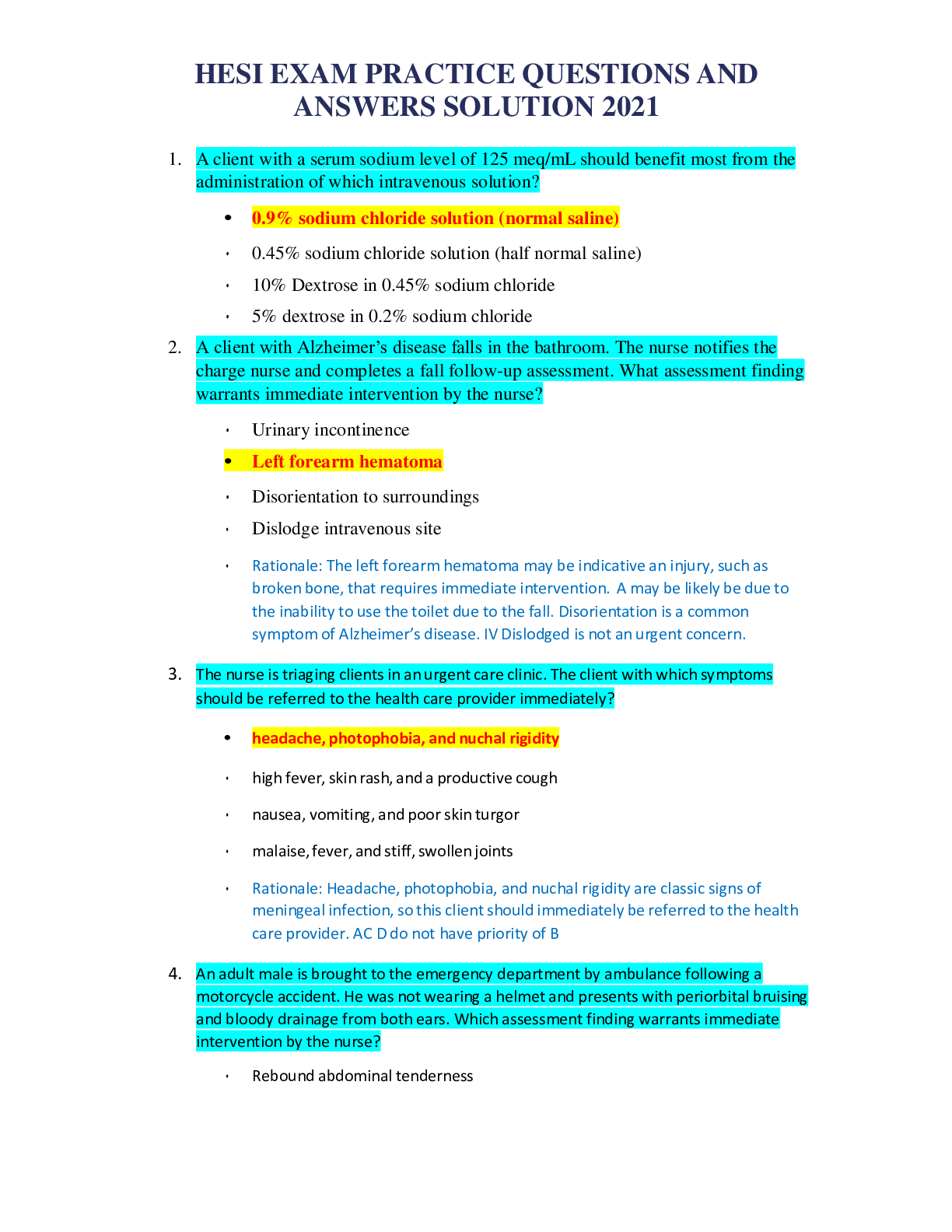
Reviews( 0 )
Document information
Connected school, study & course
About the document
Uploaded On
Apr 06, 2021
Number of pages
32
Written in
Additional information
This document has been written for:
Uploaded
Apr 06, 2021
Downloads
0
Views
43


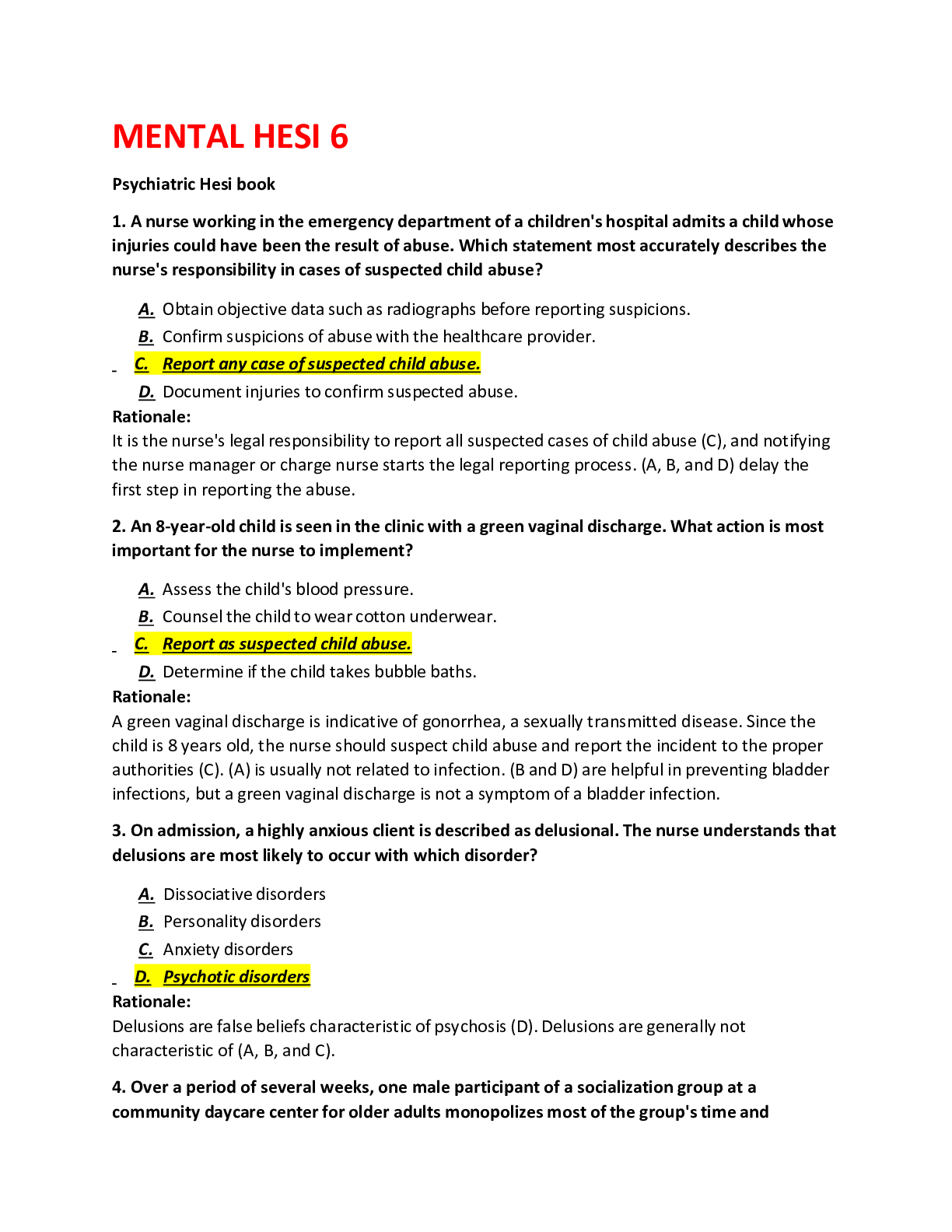
.png)
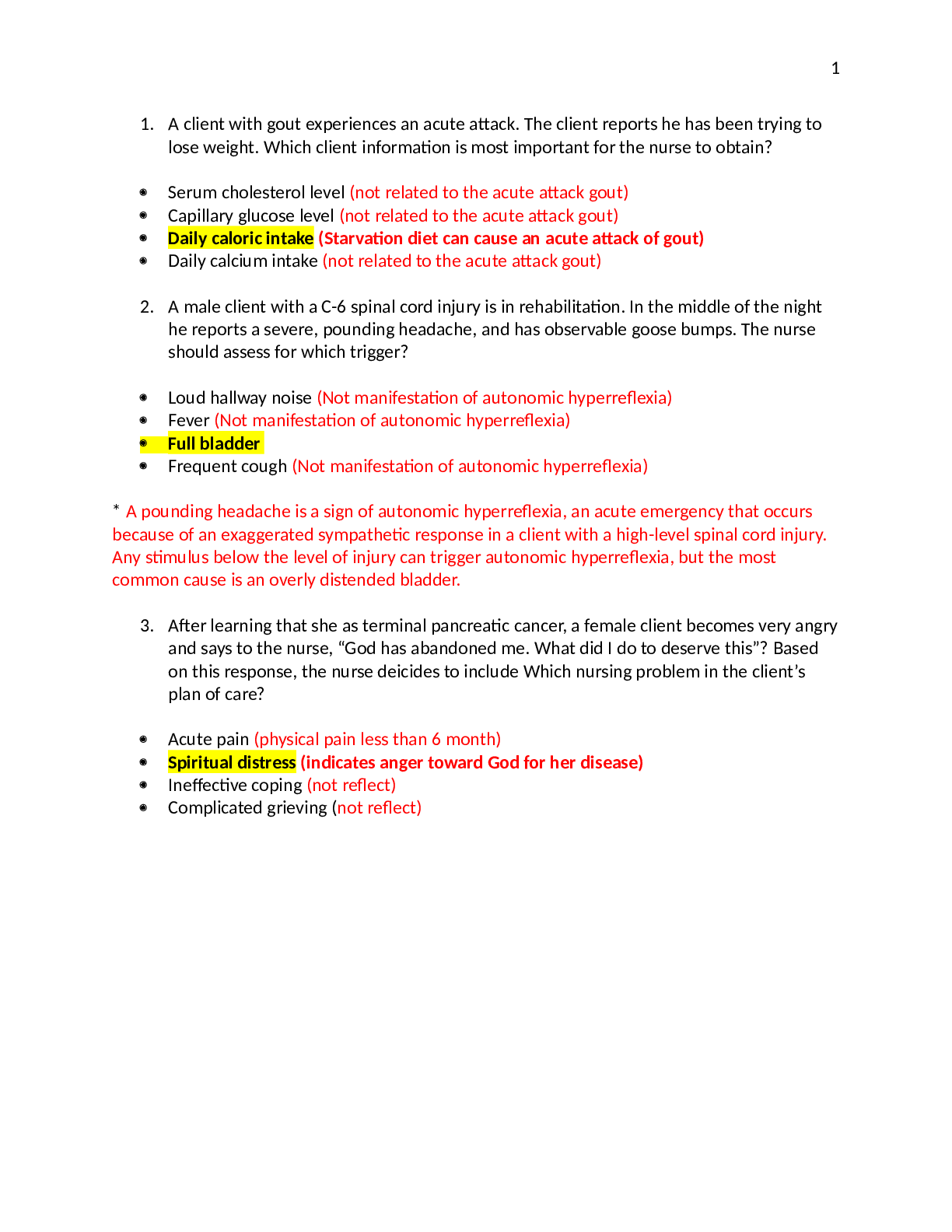
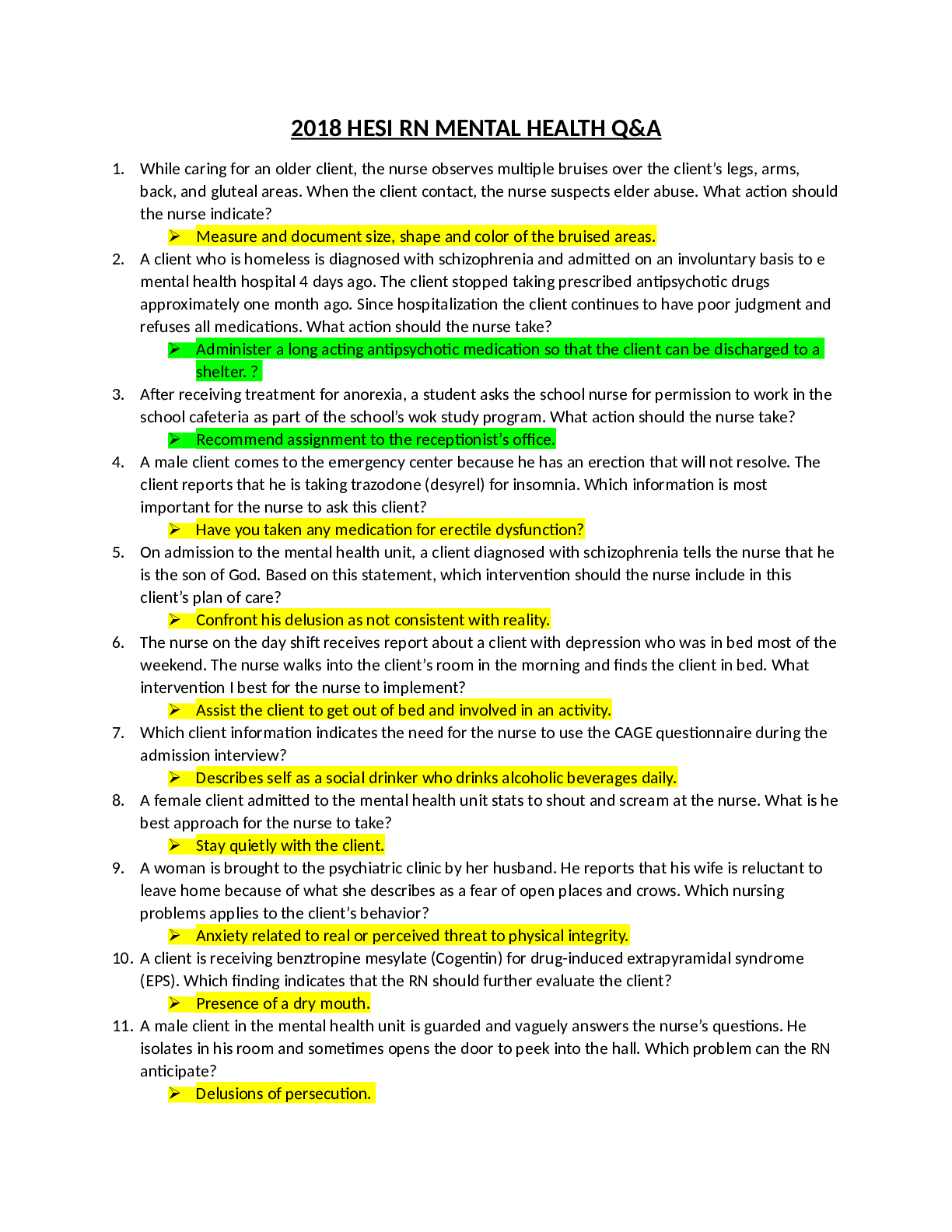
.png)

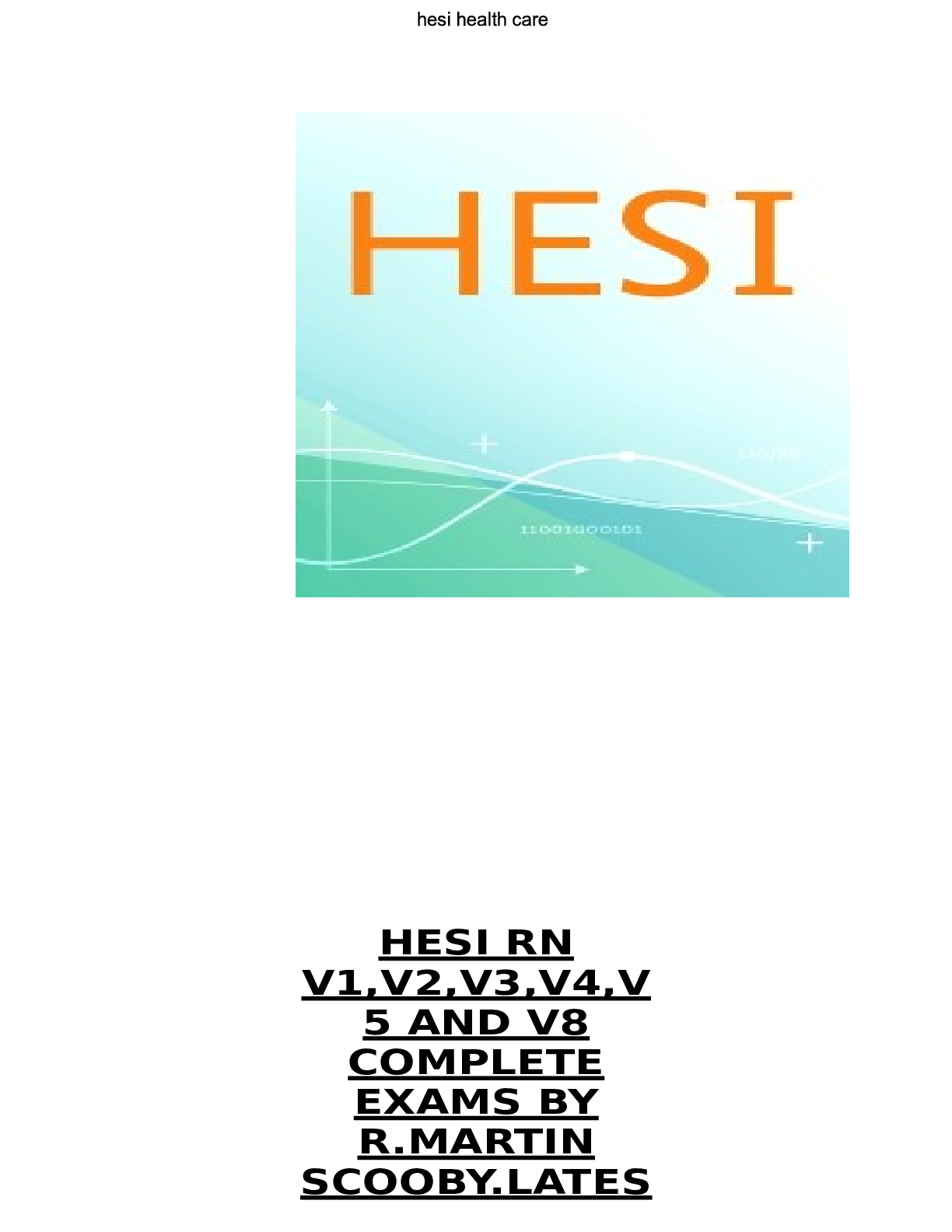
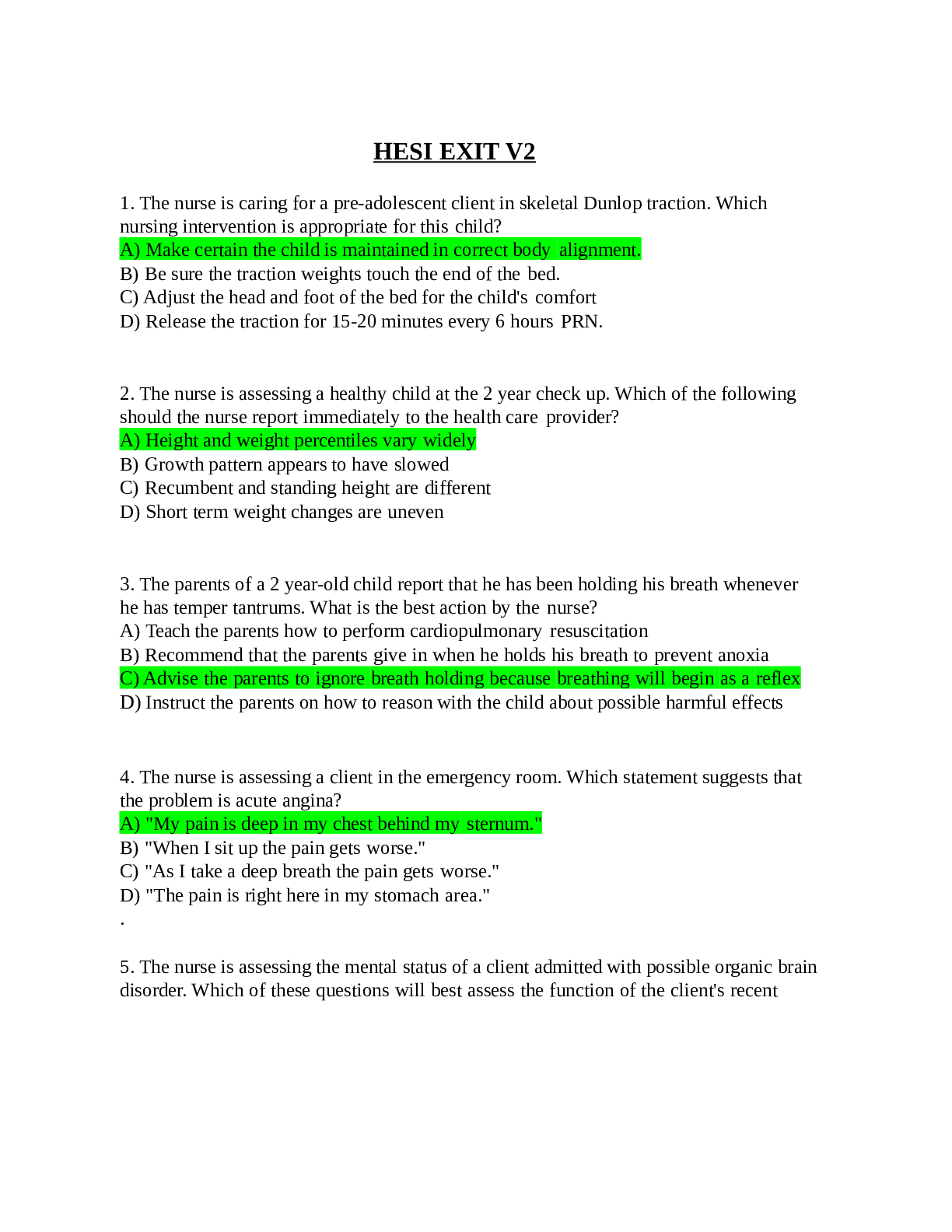
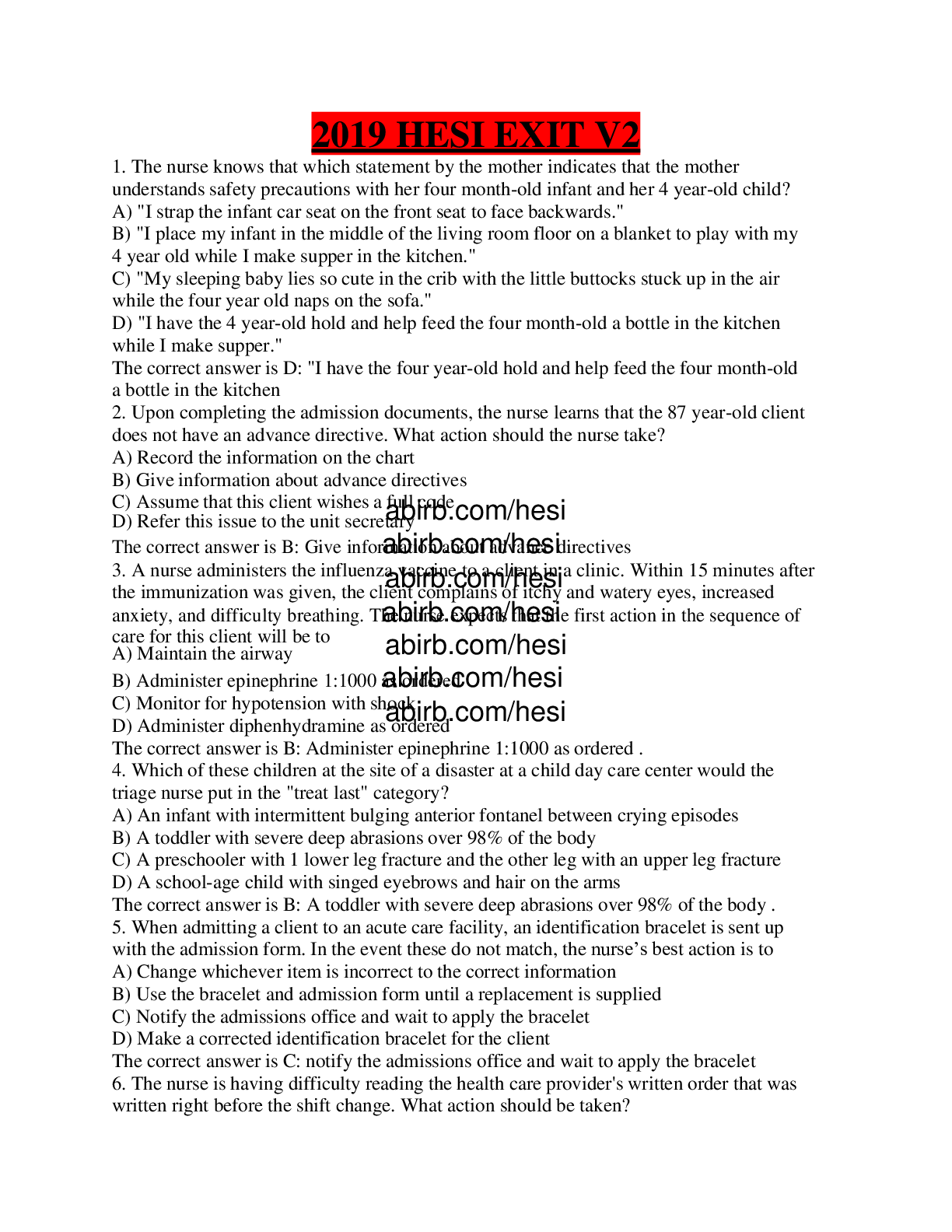
.png)
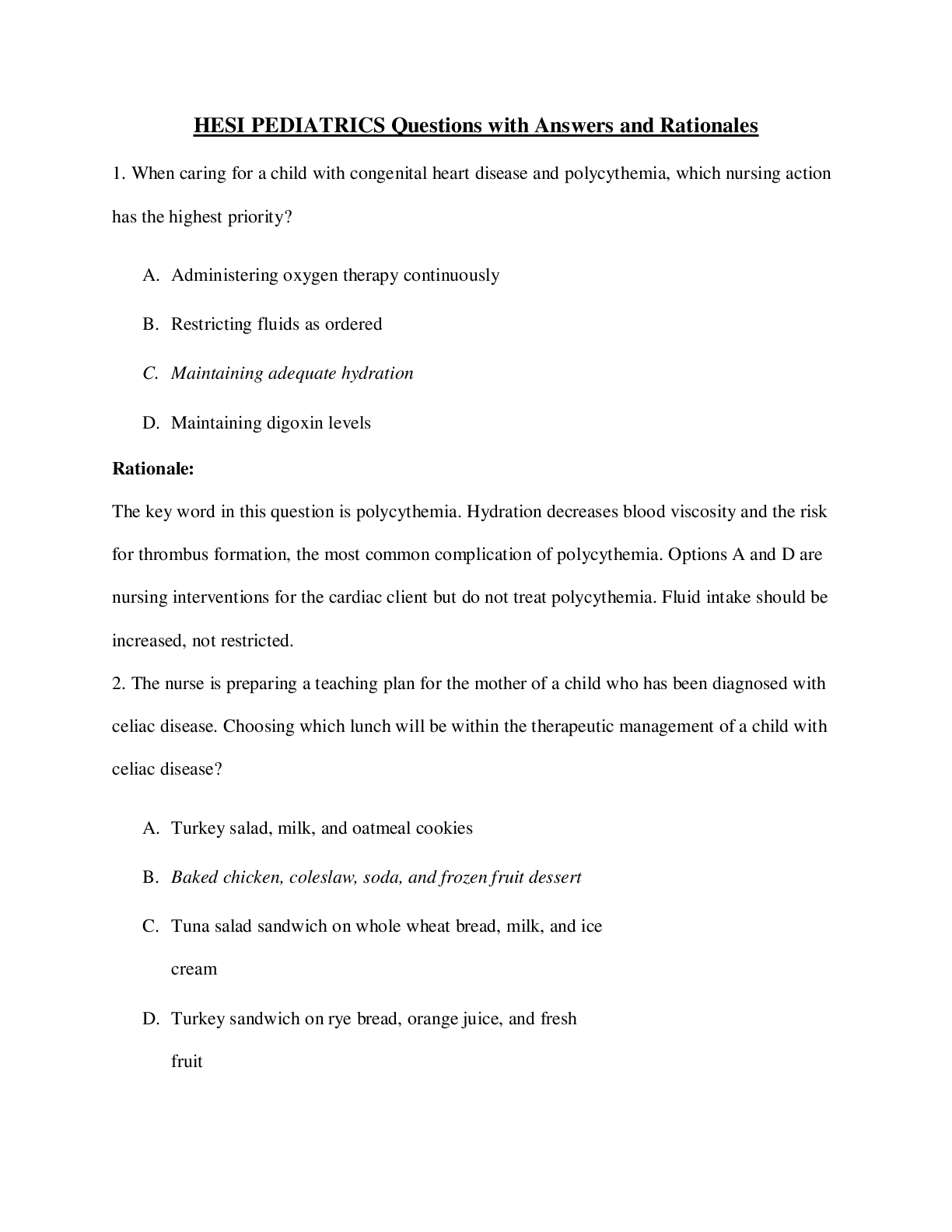
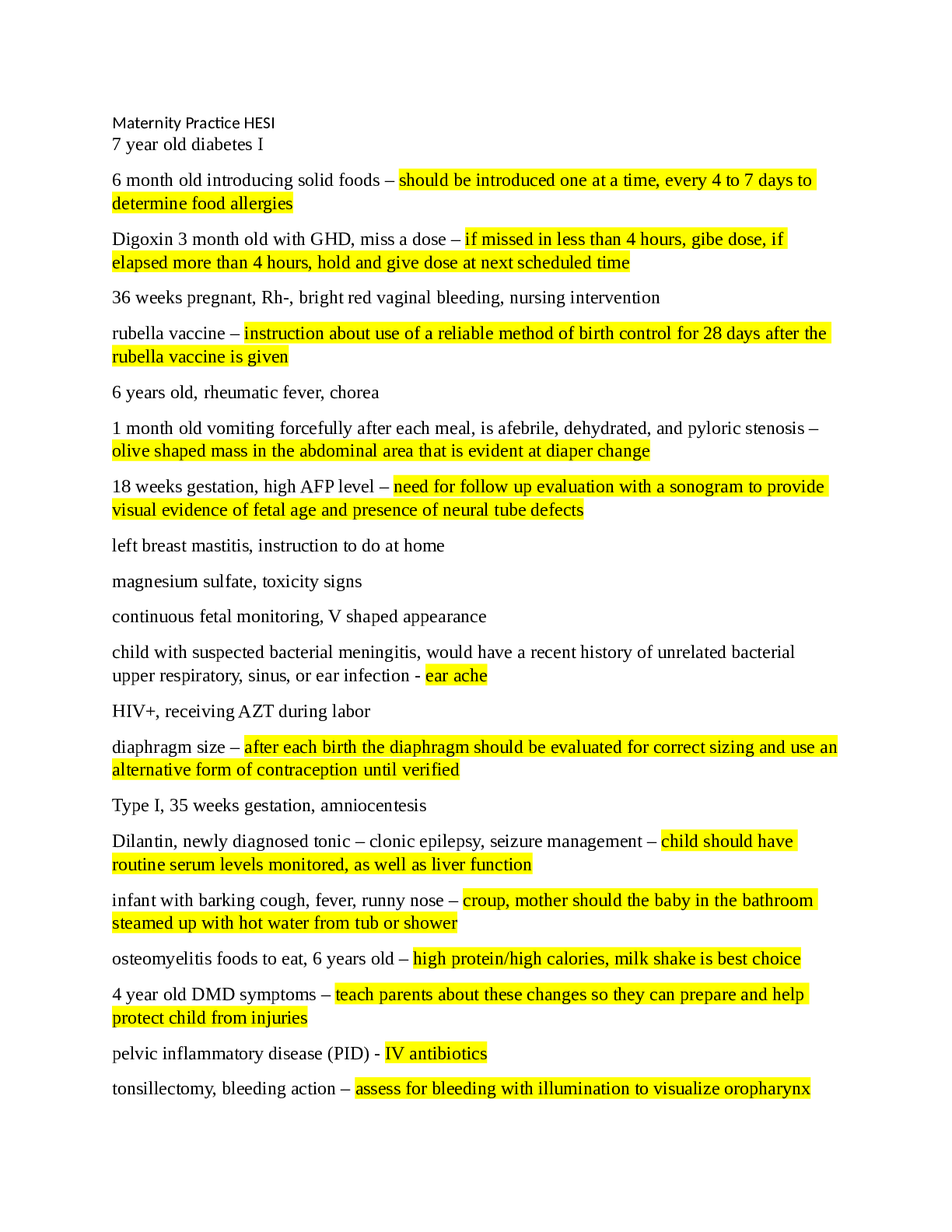
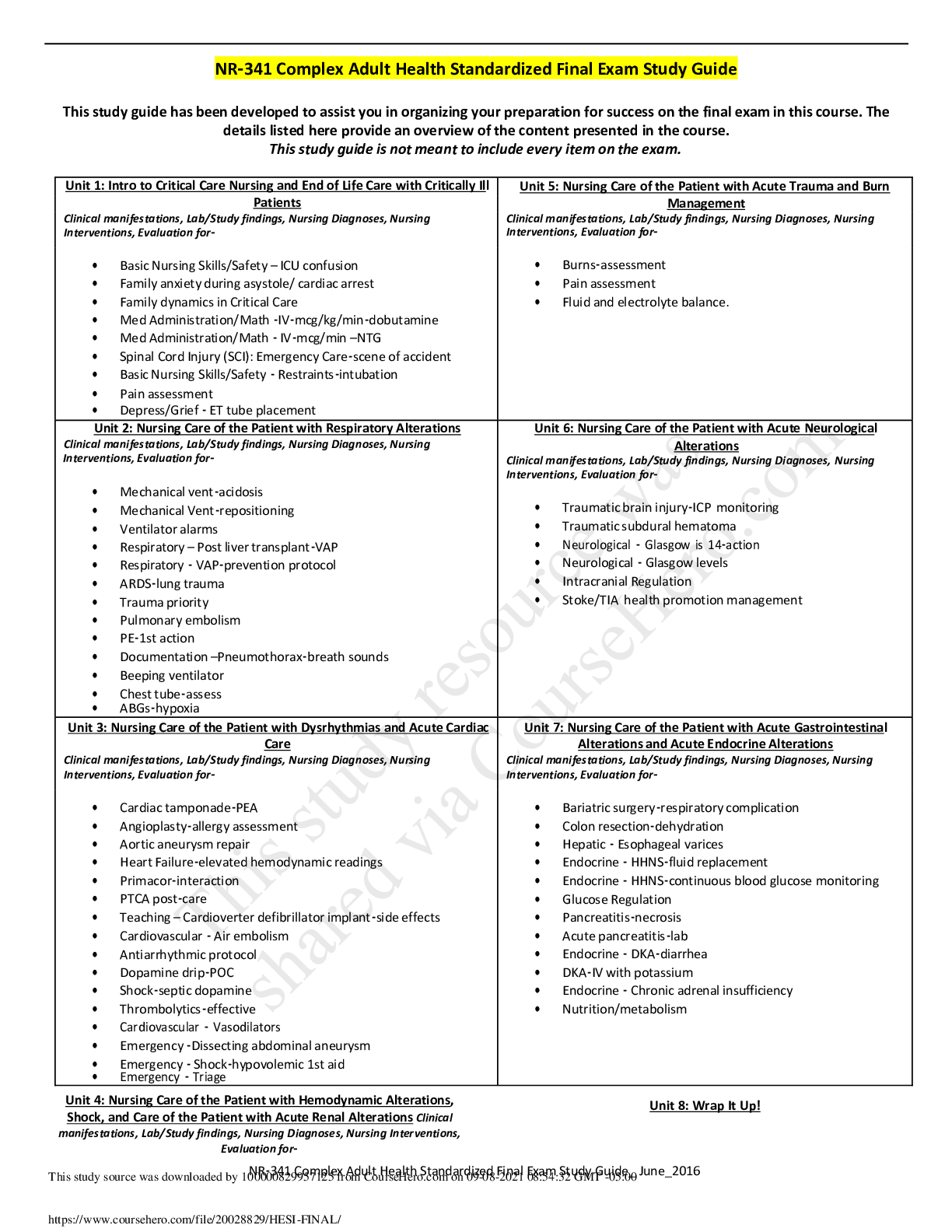
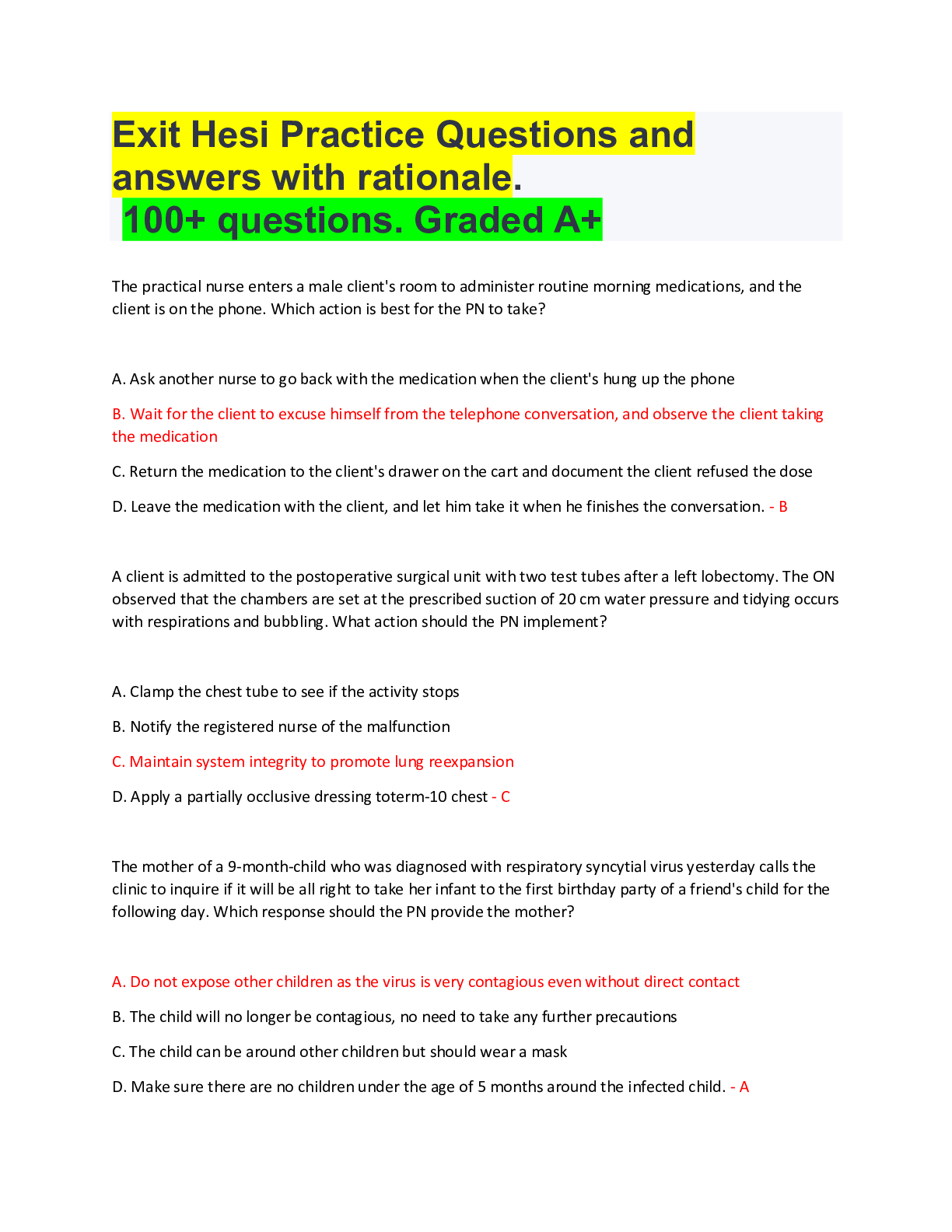
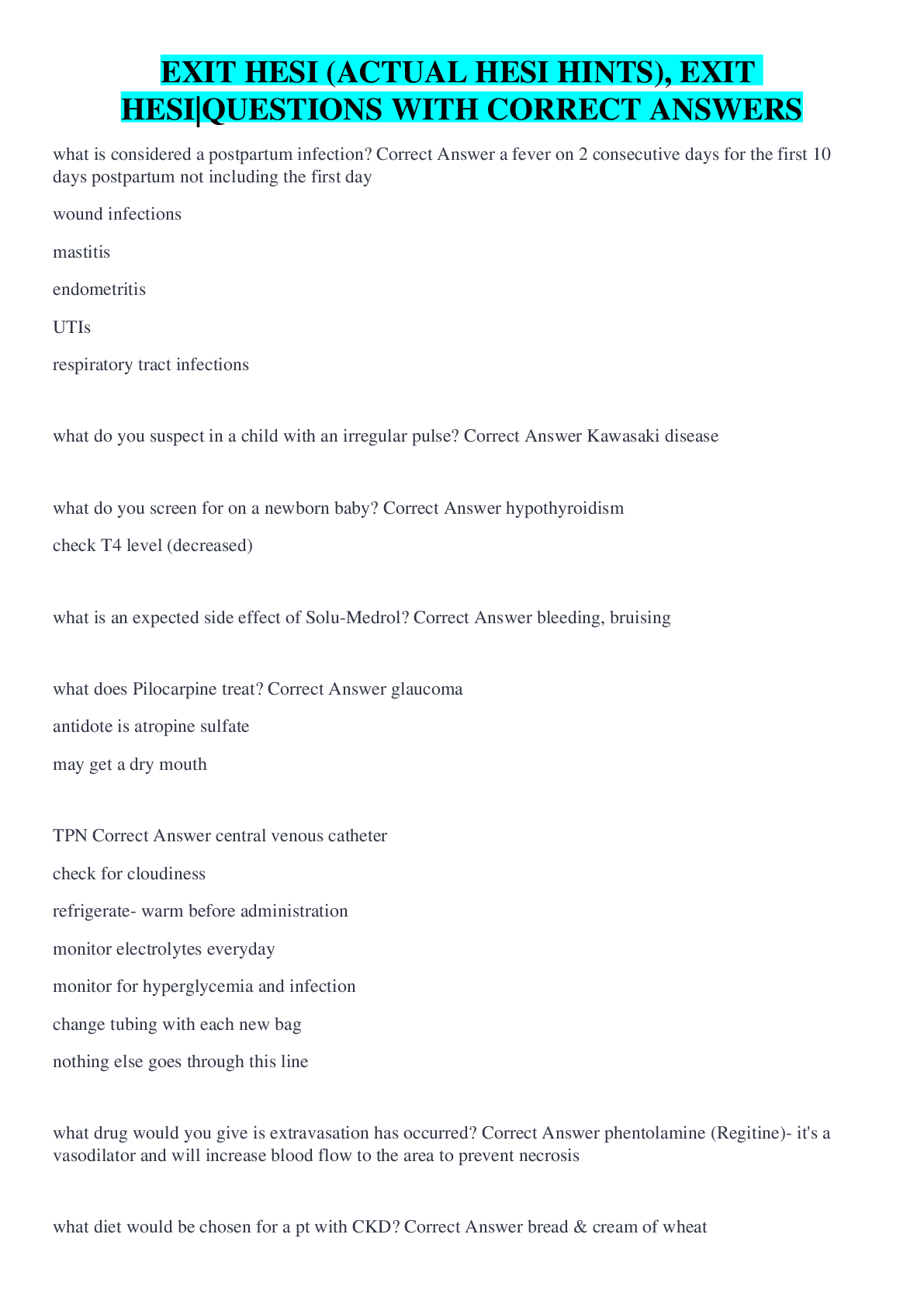
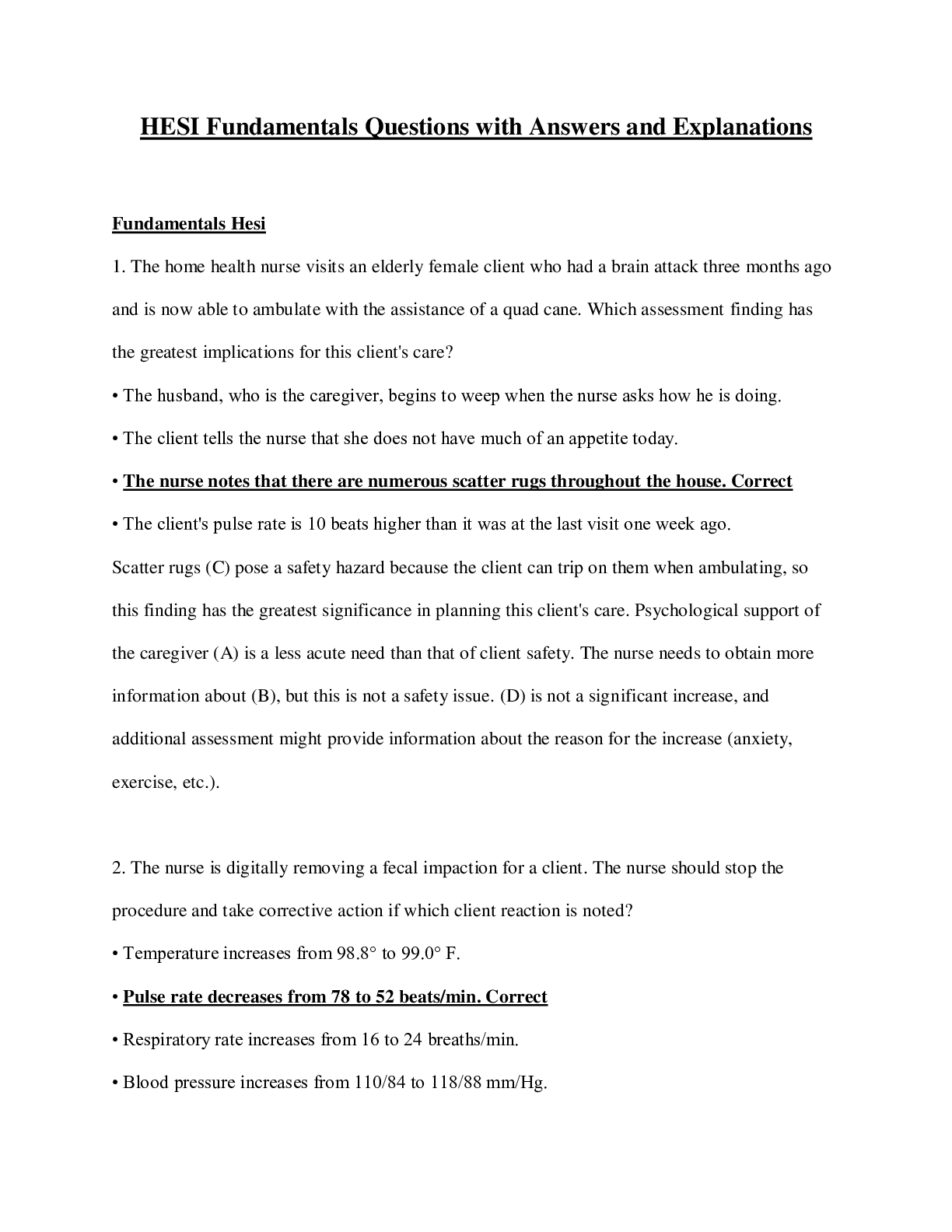
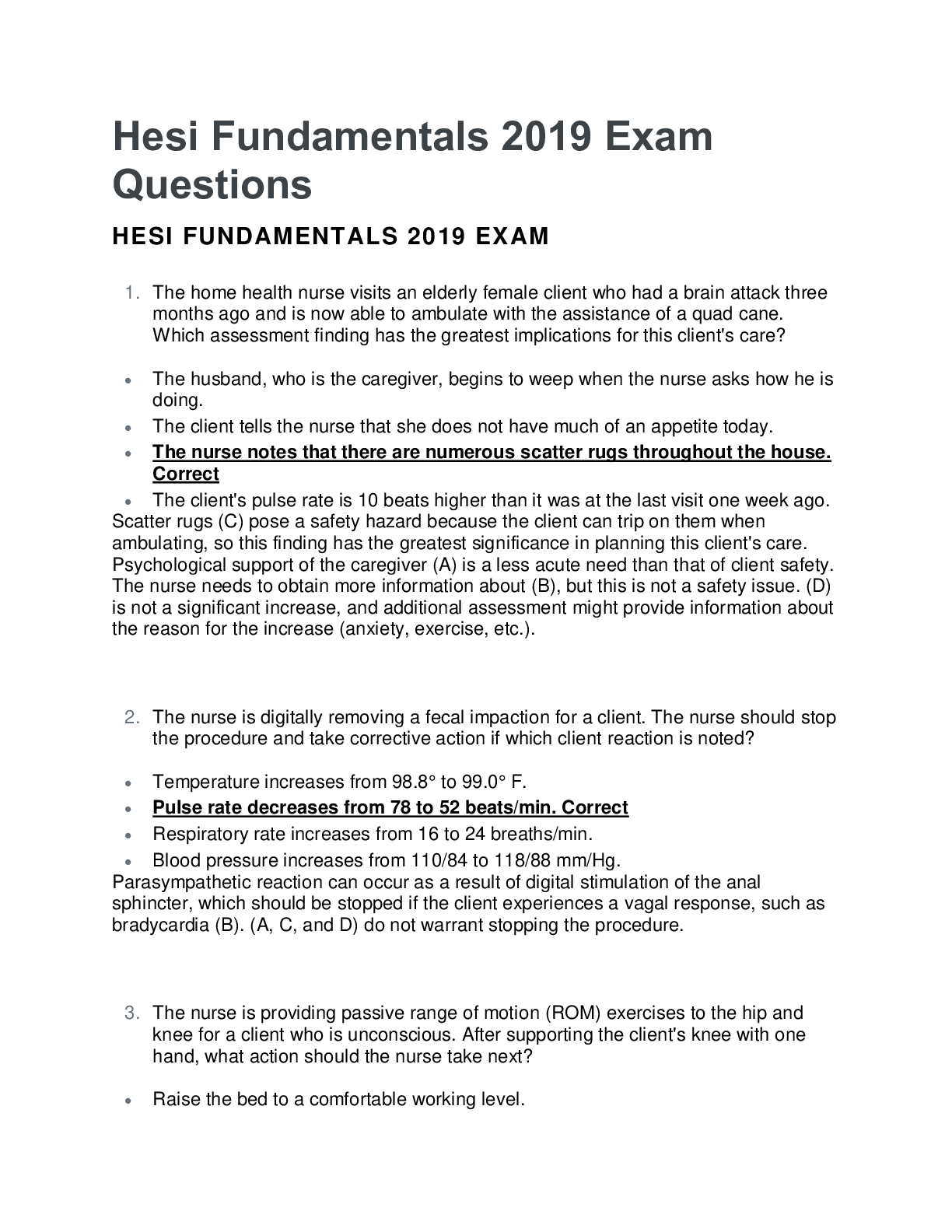
.png)
.png)
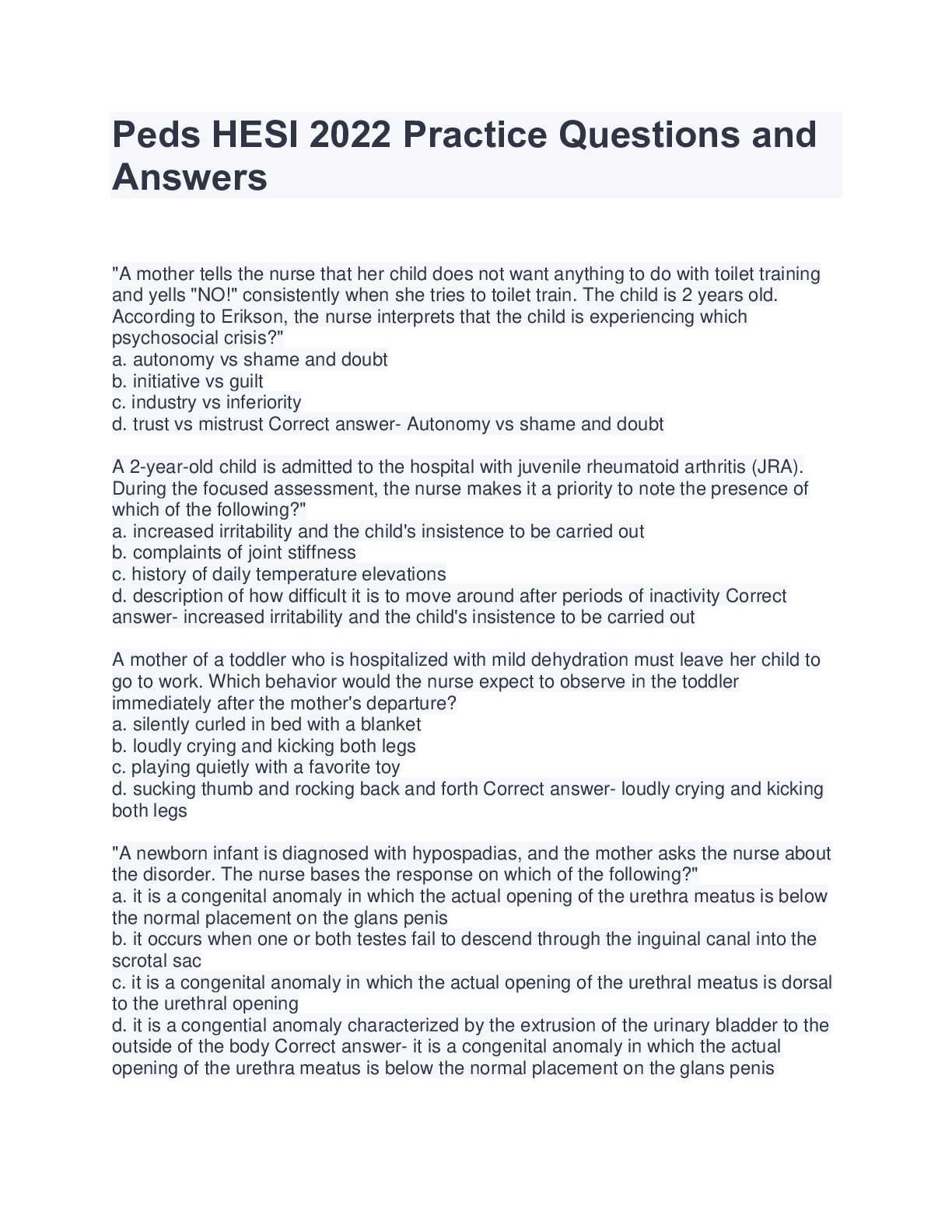
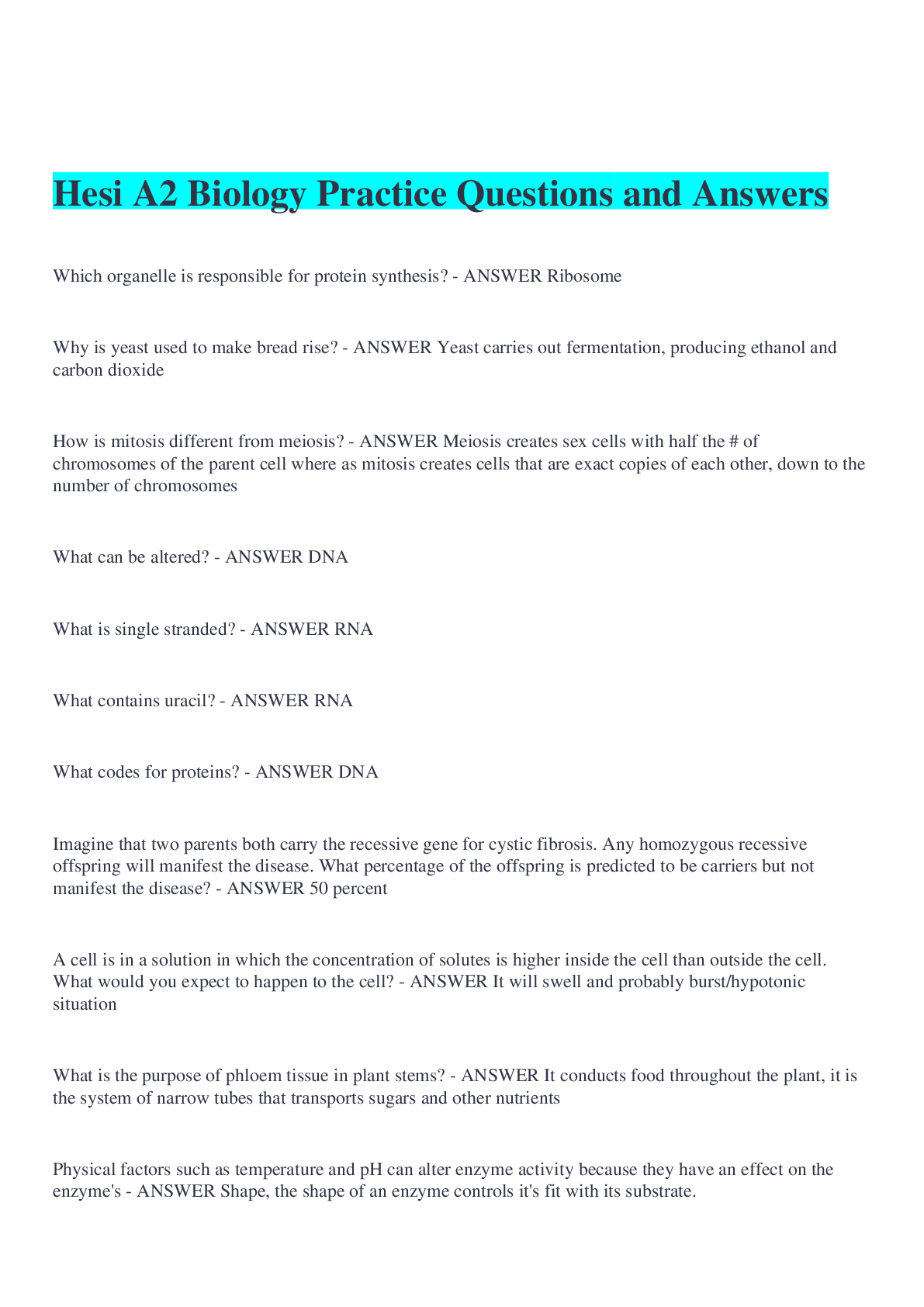
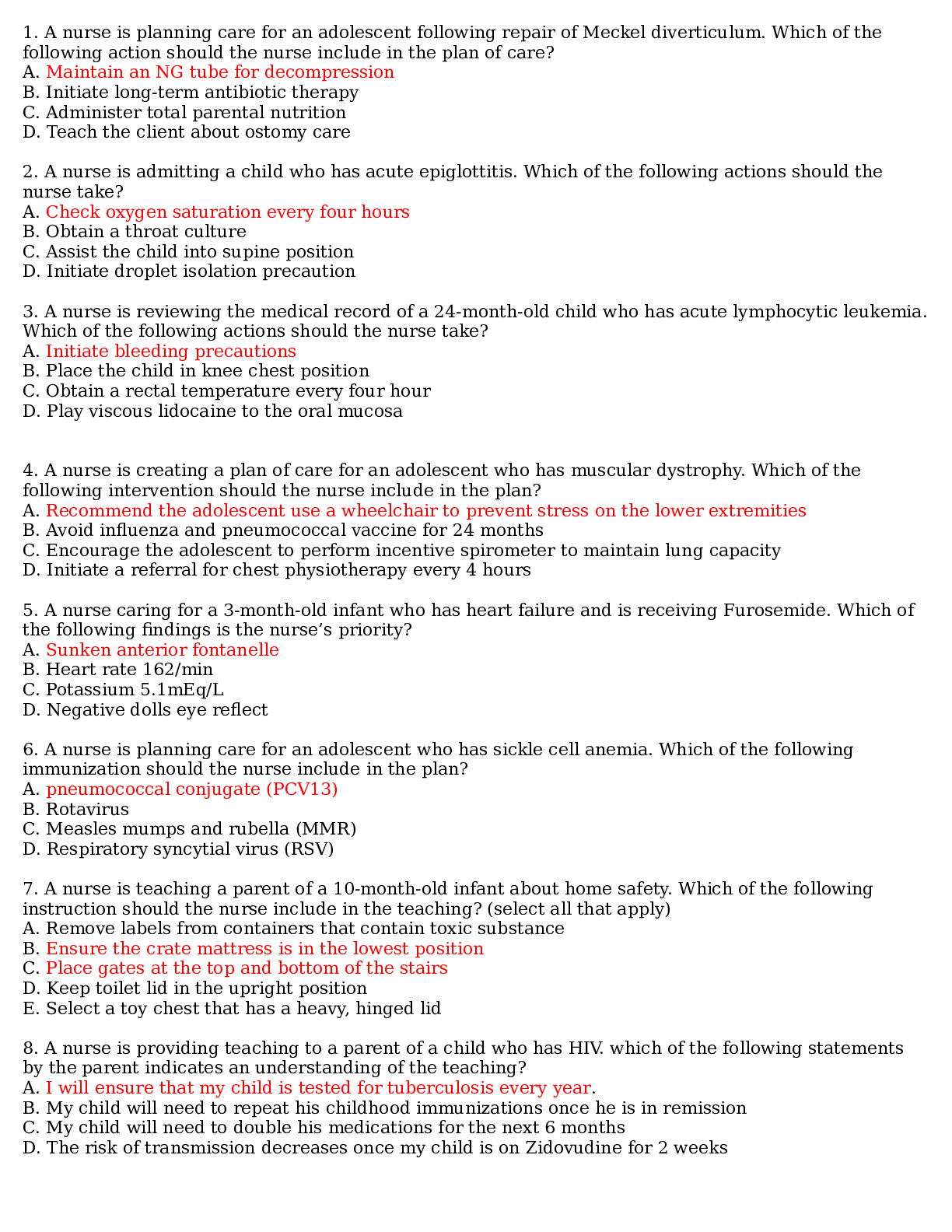

.png)
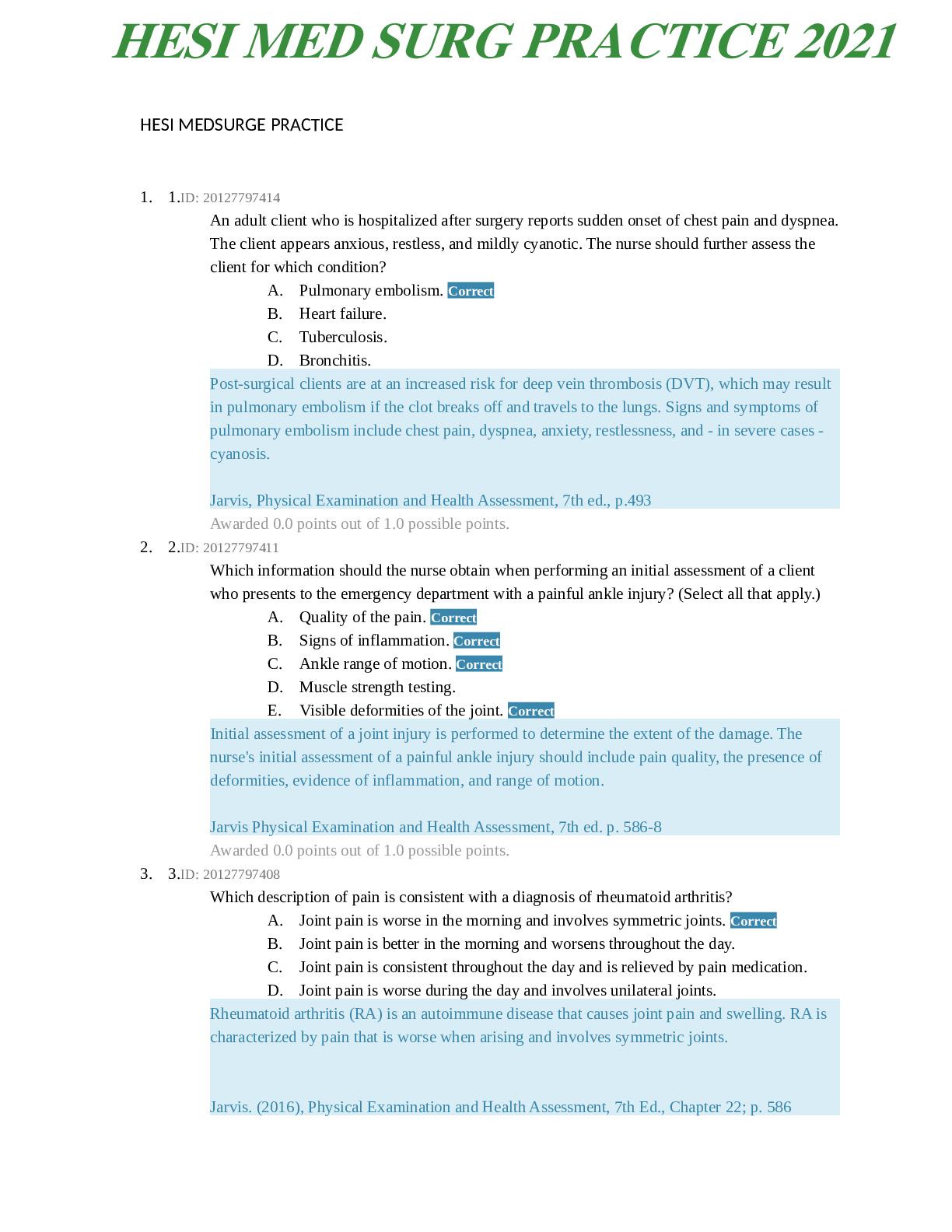
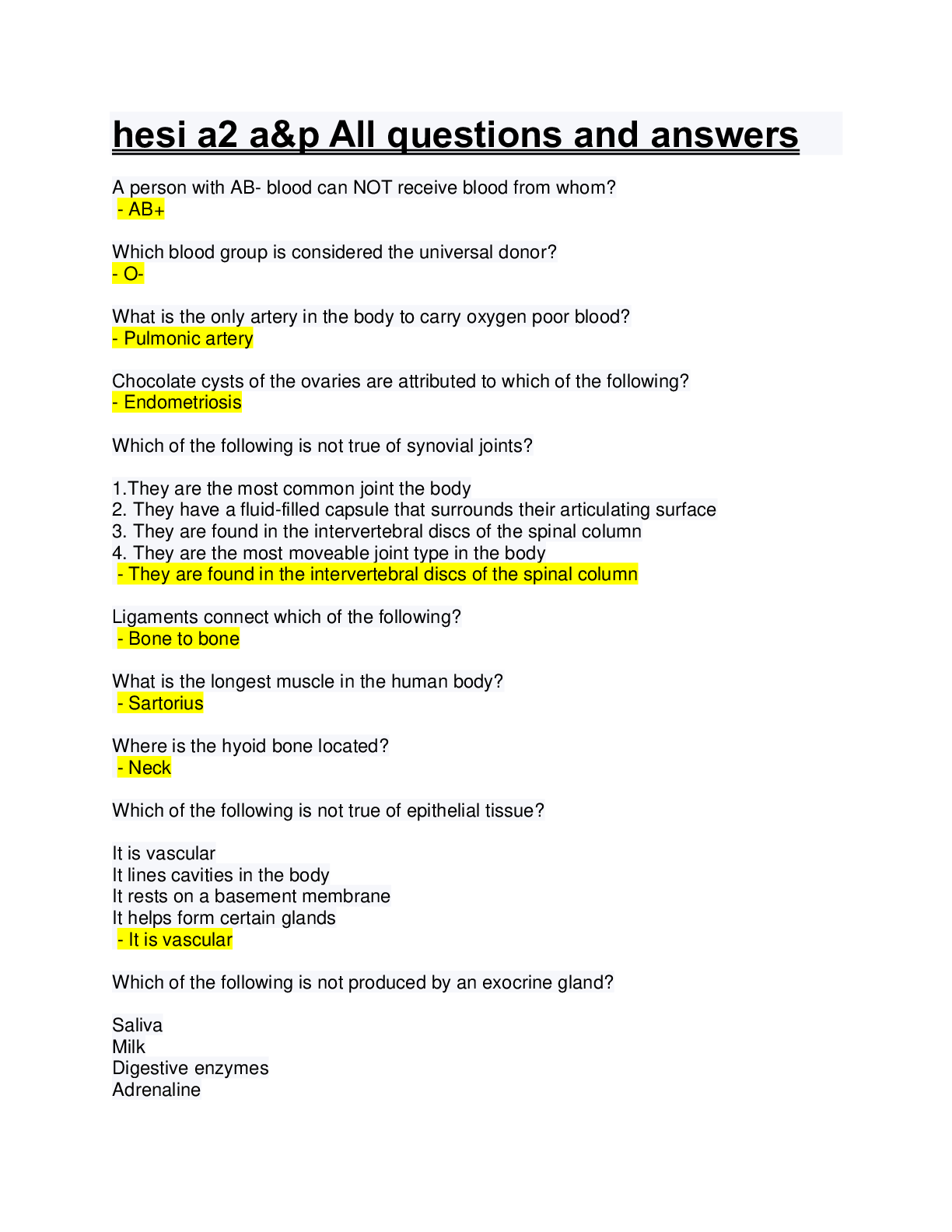
.png)

